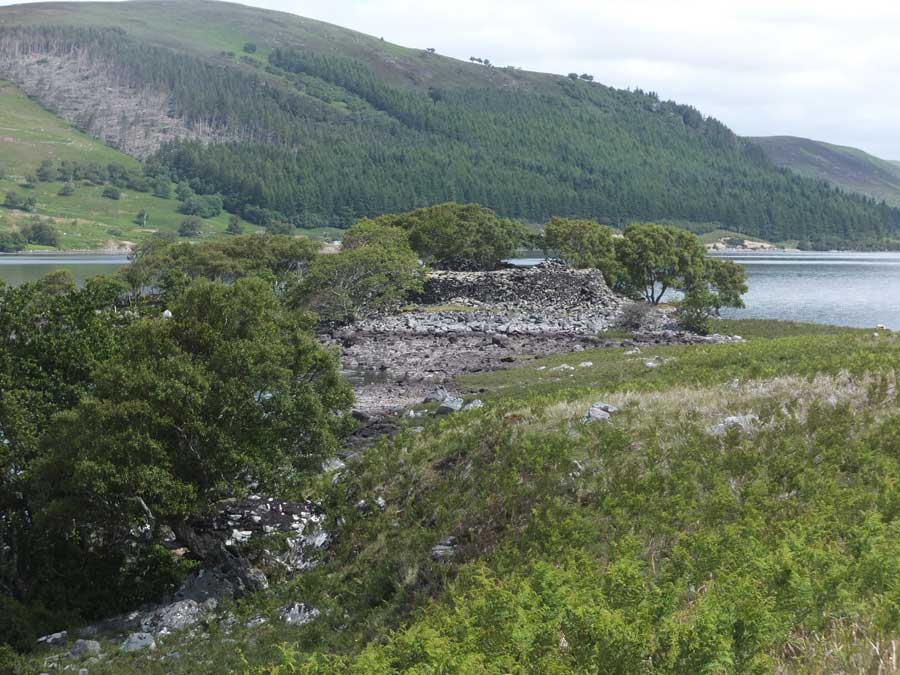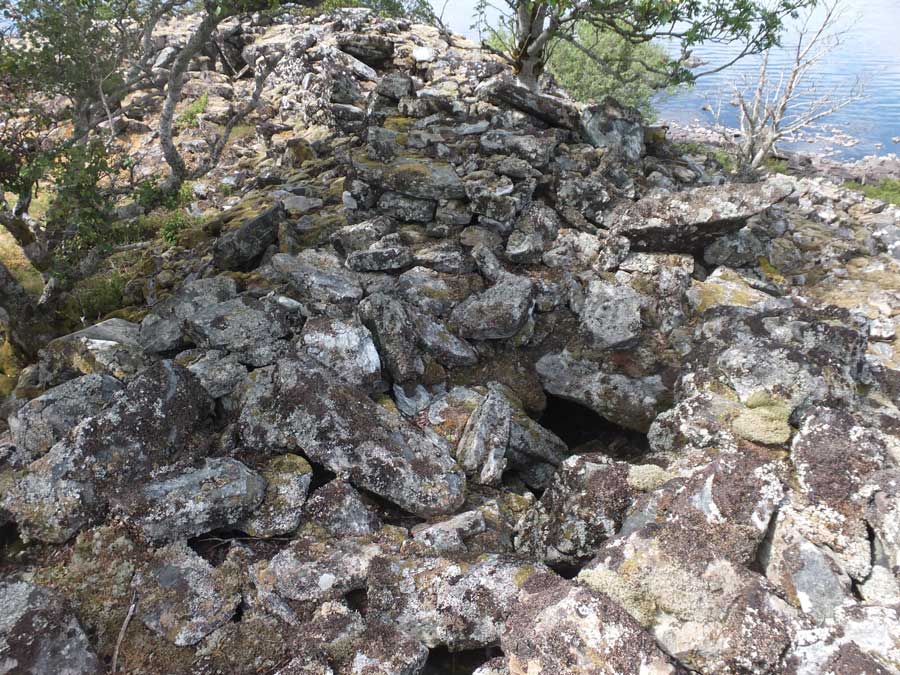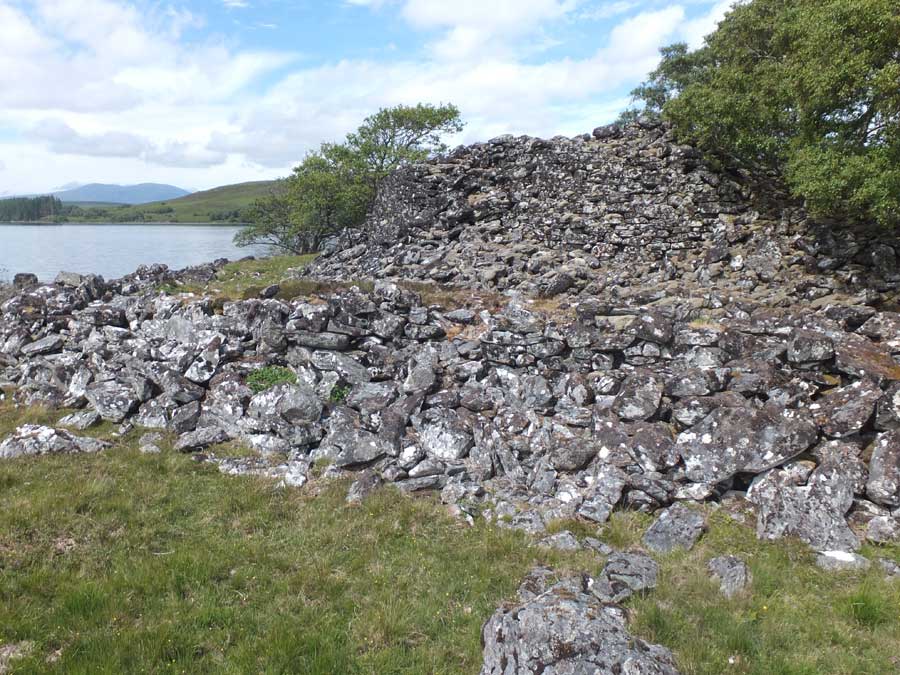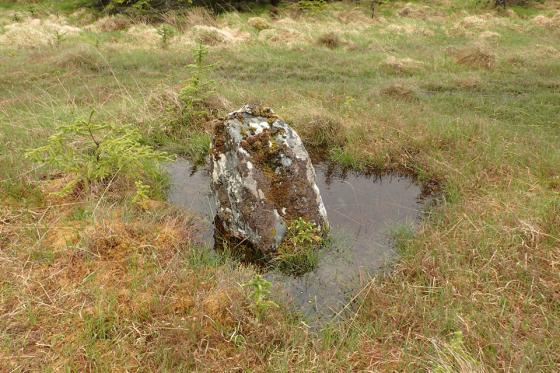
First sight of Dun Creagach, approaching along the shore of Loch Naver from Altnaharra.

First sight of Dun Creagach, approaching along the shore of Loch Naver from Altnaharra.

Dun Creagach from Loch Naver.
The variations in colour of the rocks below the broch clearly indicates how the drought has lowered the loch’s level, creating what looks like a tide mark around it.

Dun Creagach is not currently an island.
The drought has lowered the level of Loch Naver by over half a metre, creating a shelf of dry land towards the shore of the loch.

Dun Creagach seen from the northeast.

Neat courses of outer walling on the east of Dun Creagach.

This composite panoramic photograph shows the interior of the broch viewed from the east.

A section of the broch wall, hinting at the former presence of an intra-mural passage.

This composite panoramic photograph shows the interior of Dun Creagach, looking north across Loch Naver.

This image probably shows the broch’s second level.
A lintel to a probable gallery can be seen as well as a breach in the sidewall that hints strongly of a gallery within.

This section of the internal wall contains a doorway into an intra-mural gallery.

The fine entrance doorway to Dun Creagach, the actual passage now largely blocked by debris.

This image highlights the impressively thick wall of the broch at the west of the structure.

This is the impressive doorway in the south wall of Dun Creagach that leads to the intra-mural galleries.

This elevated view from the east clearly shows the relation of the protective rocky wall (rampart) with the broch.

Dun Creagach, photographed from across Loch Naver.
Visited: June 26, 2018
June 2018 proved to be an exceptionally good time to visit Dun Creagach. Normally perched on a small island, and accessible only via a causeway of rough boulders, the drought had so lowered the waters of Loch Naver that I could actually walk completely round the broch on the dried-out loch bed without fear of getting a boot wet!.
Dun Creagach is huge and mighty impressive. Possibly because of its relatively remote location, stone-robbing does not seem to have been an issue here, as evidenced by the unusually large quantity of tumbled masonry that buries much of the broch’s outer walling: certainly there are no dykes or signs of former habitation—so often the prime reason for destructuring—anywhere nearby. Of course, over the centuries, Nature has taken her toll in the shape of vast heaps of tumbled stone, mainly outside the structure. Even so, the broch walls still tower to over three metres almost everywhere around its periphery, and everywhere, the outer face stands at least a metre above the surrounding tumble.
Despite the all-encompassing rubble, there is a lot to see in the interior of the broch. The largely blocked entrance passage with its massive inclined lintel, a large almost square doorway that leads into the intra-mural galleries, and several locations where gaps in the tumble suggest strongly a void within the walls. Indeed, Canmore states that Dun Creagach ”is certainly a true hollow-walled broch“.
Dun Creagach can most easily be accessed from Altnaharra, from a point just south of the village, walking up the road that heads to Klibreck Lodge. Just 50 metres south of this point, on the A836, is an enlarged passing place, where there is room to park several cars without compromising its use by road traffic.
The distance to the broch is almost exactly 4 km, the first 1.5 km on a metalled road as far as the Lodge. On reaching the Lodge, head right for a few meters then left round the building to a field gate and continue along a good dirt road that continues east. Two streams (marked ‘ford’ on the OS map) are actually now crossed by footbridges before the path peters out at the edge of a wooded plantation.
Now comes the tricky part: It is important to continue due east through woodland to a third stream. This is where I came unstuck, losing direction and heading away from Loch Naver. On reflection, I might have been better following the second stream to the shore, then continuing along the lochside to the broch.
In all, it took just an hour and a quarter to reach Dun Creagach, but underfoot conditions were particularly easy with the ground being parched: there were none of the usual bogs to negotiate.
This is a broch for the connaisseur, with much to see and enjoy. It takes more than the usual effort to make its acquaintance—a round trip on foot of some eight kilometres—but has so much to offer in return.
I had intended to visit this broch during June 2017 but having lost a day of my trip north to atrocious weather, had to leave this for a future visit. However, I did gain a chance view of Dun Creagach from across Loch Naver when visiting Grummore broch.
Canmore tells that this is a ‘well preserved and comparatively undisturbed’ broch which has been built on a small island, and which is connected to the shore by a causeway. Although much rubble surrounds the structure, the walling still stands over three metres tall in places and can be traced almost all round the broch.






















